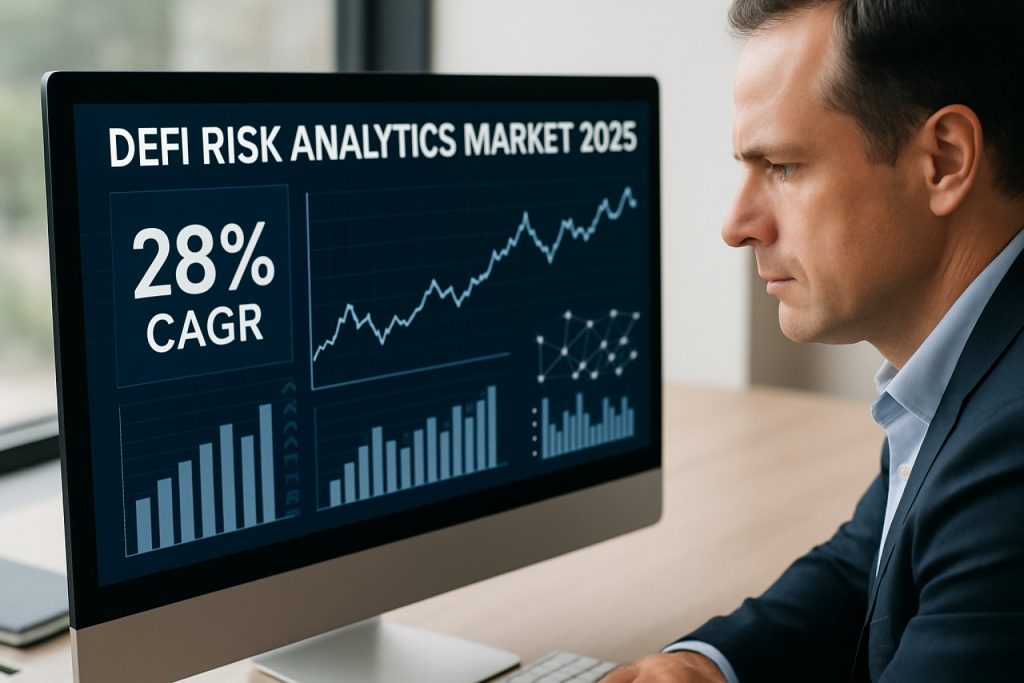
DeFi Risk Analytics Industry Report 2025: Navigating Rapid Growth, AI Integration, and Evolving Regulatory Landscapes. Discover Key Trends, Market Forecasts, and Strategic Opportunities Shaping the Next 5 Years.
- Executive Summary & Market Overview
- Key Technology Trends in DeFi Risk Analytics
- Competitive Landscape and Leading Players
- Market Growth Forecasts (2025–2030): CAGR, Revenue, and Adoption Rates
- Regional Analysis: North America, Europe, APAC, and Emerging Markets
- Future Outlook: Innovations, Regulatory Developments, and Market Expansion
- Challenges and Opportunities: Security, Compliance, and Scalability
- Sources & References
Executive Summary & Market Overview
Decentralized Finance (DeFi) Risk Analytics refers to the suite of tools, methodologies, and platforms designed to identify, quantify, and manage risks inherent in DeFi protocols and applications. As DeFi continues its rapid expansion—total value locked (TVL) in DeFi protocols surpassed $100 billion in early 2024 and is projected to grow further in 2025—the need for robust risk analytics has become paramount for institutional and retail participants alike. The DeFi ecosystem, built on blockchain technology and smart contracts, introduces unique risks such as smart contract vulnerabilities, protocol exploits, oracle manipulation, and systemic liquidity shocks, which traditional financial risk models are ill-equipped to address.
In 2025, the DeFi Risk Analytics market is characterized by increasing sophistication and adoption of analytics platforms. Leading analytics providers, such as Chainalysis, Nansen, and Gauntlet, have expanded their offerings to include real-time risk scoring, on-chain monitoring, and predictive analytics tailored to DeFi protocols. These platforms leverage machine learning, big data, and blockchain forensics to deliver actionable insights for investors, developers, and regulators.
Market growth is driven by several factors:
- Regulatory Scrutiny: Global regulators, including the Financial Action Task Force (FATF) and U.S. Securities and Exchange Commission (SEC), are intensifying oversight of DeFi, prompting protocols and investors to adopt advanced risk analytics for compliance and due diligence.
- Institutional Participation: The entry of institutional capital into DeFi has heightened demand for enterprise-grade risk assessment tools, as highlighted in recent reports by ConsenSys and Messari.
- High-Profile Exploits: A series of high-value DeFi hacks in 2023 and 2024, including the $200 million Euler Finance exploit, have underscored the necessity for continuous risk monitoring and analytics (The Block).
Looking ahead to 2025, the DeFi Risk Analytics sector is expected to see further innovation, with the integration of AI-driven anomaly detection, cross-chain risk assessment, and automated incident response. As DeFi matures, risk analytics will play a central role in safeguarding assets, fostering trust, and enabling sustainable growth in the decentralized financial ecosystem.
Key Technology Trends in DeFi Risk Analytics
Decentralized Finance (DeFi) risk analytics is rapidly evolving, driven by the sector’s explosive growth and the increasing sophistication of both threats and mitigation strategies. In 2025, several key technology trends are shaping the landscape of DeFi risk analytics, reflecting the need for real-time, transparent, and predictive risk management tools.
- On-Chain Data Analytics and Machine Learning: The integration of advanced machine learning algorithms with on-chain data is enabling more accurate detection of anomalies, such as flash loan attacks, oracle manipulations, and smart contract exploits. Platforms are leveraging vast blockchain datasets to train models that can identify suspicious patterns and predict potential vulnerabilities before they are exploited. This trend is exemplified by solutions from Chainalysis and Nansen, which provide real-time risk scoring and behavioral analytics for DeFi protocols.
- Automated Smart Contract Auditing: Automated tools for smart contract auditing are becoming more sophisticated, utilizing static and dynamic analysis to uncover vulnerabilities. These tools, such as those developed by ConsenSys Diligence and CertiK, are increasingly integrated into continuous deployment pipelines, allowing for ongoing risk assessment as code evolves.
- Cross-Protocol Risk Aggregation: As DeFi users interact with multiple protocols, risk analytics platforms are aggregating data across chains and protocols to provide holistic risk profiles. This cross-protocol analysis is crucial for understanding systemic risks and contagion effects, especially in the context of composable DeFi products. Gauntlet and DeFiLlama are notable for their efforts in aggregating and modeling protocol-level and ecosystem-wide risks.
- Decentralized Oracles and Real-Time Monitoring: The reliability of oracles remains a critical risk vector. In 2025, decentralized oracle networks like Chainlink are enhancing their analytics capabilities, offering real-time monitoring and alerting for data feed anomalies, which helps mitigate risks associated with price manipulation and data outages.
- Regulatory Technology (RegTech) Integration: With increasing regulatory scrutiny, DeFi risk analytics platforms are incorporating RegTech solutions to automate compliance checks, monitor for illicit activity, and generate audit trails. This trend is supported by partnerships between analytics firms and regulatory bodies, as seen with Elliptic and TRM Labs.
These technology trends are collectively enhancing the resilience and transparency of the DeFi ecosystem, enabling stakeholders to better anticipate, quantify, and mitigate risks in an increasingly complex environment.
Competitive Landscape and Leading Players
The competitive landscape of the DeFi risk analytics market in 2025 is characterized by rapid innovation, a growing number of specialized providers, and increasing integration with both institutional and retail DeFi participants. As decentralized finance (DeFi) protocols continue to proliferate and attract significant capital, the demand for robust risk analytics solutions has intensified. This has led to the emergence of a diverse ecosystem of analytics platforms, each offering unique approaches to risk assessment, monitoring, and mitigation.
Leading players in the DeFi risk analytics space include both established blockchain analytics firms and newer, DeFi-native startups. Chainalysis has expanded its suite of tools to include DeFi protocol risk scoring, leveraging its extensive blockchain data infrastructure. Gauntlet remains a prominent player, providing simulation-based risk modeling and parameter optimization for major protocols such as Aave and Compound. DeFiSafety offers protocol security assessments and transparency ratings, which are increasingly referenced by institutional investors.
Other notable entrants include CertiK, which combines smart contract auditing with real-time risk monitoring dashboards, and DeFiLlama, which has integrated risk metrics into its widely used DeFi analytics platform. Risk DAO and Chaos Labs are gaining traction for their community-driven and automated risk management frameworks, respectively.
The competitive dynamics are shaped by several factors:
- Technological Differentiation: Firms are competing on the sophistication of their risk models, with some leveraging machine learning and on-chain data aggregation to provide real-time, protocol-specific risk insights.
- Integration Capabilities: Leading platforms are increasingly offering APIs and plug-ins for DeFi protocols, wallets, and institutional dashboards, enabling seamless risk monitoring and reporting.
- Regulatory Alignment: As regulatory scrutiny intensifies, analytics providers that can offer compliance-ready risk assessments are gaining favor among institutional clients.
- Community Trust: Open-source methodologies and transparent scoring systems are helping newer entrants build credibility in a market wary of opaque risk models.
Overall, the DeFi risk analytics market in 2025 is marked by both consolidation among top-tier providers and ongoing innovation from agile startups, as the sector responds to evolving threats and the growing sophistication of DeFi participants.
Market Growth Forecasts (2025–2030): CAGR, Revenue, and Adoption Rates
The DeFi (Decentralized Finance) risk analytics market is poised for robust growth between 2025 and 2030, driven by the accelerating adoption of DeFi protocols and the increasing sophistication of associated risks. According to projections from Grand View Research, the global DeFi market is expected to expand at a compound annual growth rate (CAGR) exceeding 40% during this period, with risk analytics solutions capturing a significant share as institutional and retail investors demand more advanced risk management tools.
Revenue generated by DeFi risk analytics platforms is forecasted to surpass $2.5 billion by 2030, up from an estimated $400 million in 2025. This surge is attributed to the proliferation of new DeFi protocols, the growing complexity of smart contracts, and the heightened regulatory scrutiny that compels market participants to adopt robust risk assessment frameworks. MarketsandMarkets highlights that the increasing frequency of exploits and protocol failures is pushing DeFi platforms and investors to integrate real-time analytics and automated risk scoring solutions.
Adoption rates of DeFi risk analytics tools are expected to rise sharply, with institutional adoption projected to grow from 15% in 2025 to over 50% by 2030, as per Chainalysis research. Retail user adoption is also set to increase, albeit at a slower pace, reaching approximately 30% by 2030. The integration of AI and machine learning into risk analytics platforms is anticipated to further accelerate adoption, enabling more accurate detection of vulnerabilities and predictive risk modeling.
Regionally, North America and Europe are expected to lead in both revenue and adoption rates, driven by the presence of major DeFi projects and a mature regulatory environment. However, Asia-Pacific is forecasted to exhibit the fastest CAGR, fueled by rapid fintech innovation and increasing DeFi participation in markets such as Singapore and South Korea (Bank for International Settlements).
In summary, the period from 2025 to 2030 will likely see DeFi risk analytics transition from a niche offering to a core component of the DeFi ecosystem, underpinned by strong revenue growth, rising adoption rates, and technological advancements that address the evolving risk landscape.
Regional Analysis: North America, Europe, APAC, and Emerging Markets
The regional landscape for DeFi risk analytics in 2025 is shaped by varying levels of decentralized finance (DeFi) adoption, regulatory maturity, and technological infrastructure across North America, Europe, Asia-Pacific (APAC), and emerging markets.
North America remains the global leader in DeFi risk analytics, driven by the United States’ robust venture capital ecosystem and the presence of major blockchain analytics firms. The region’s regulatory scrutiny, particularly from the U.S. Securities and Exchange Commission and FINRA, has accelerated demand for advanced risk analytics tools that address compliance, anti-money laundering (AML), and smart contract vulnerabilities. Companies such as Chainalysis and Consensys are at the forefront, offering solutions that integrate real-time risk scoring and transaction monitoring for DeFi protocols.
Europe is characterized by a rapidly evolving regulatory framework, notably the Markets in Crypto-Assets Regulation (MiCA) introduced by the European Parliament. This has spurred DeFi platforms and analytics providers to prioritize transparency and risk mitigation. European firms such as Scorechain and Elliptic are expanding their DeFi risk analytics offerings, focusing on cross-border compliance and transaction risk assessment. The region’s emphasis on consumer protection and data privacy is shaping the development of analytics tools tailored to local regulatory requirements.
- APAC is witnessing rapid DeFi adoption, particularly in Singapore, Hong Kong, and South Korea. Regulatory sandboxes and government-backed blockchain initiatives, such as those by the Monetary Authority of Singapore, are fostering innovation in DeFi risk analytics. Local firms and global players are collaborating to address unique risks, including high-frequency trading and protocol exploits prevalent in the region’s dynamic DeFi markets.
- Emerging Markets—notably in Latin America and Africa—are leveraging DeFi for financial inclusion, but face challenges such as limited regulatory clarity and lower digital literacy. Risk analytics adoption is nascent, with a focus on basic fraud detection and transaction monitoring. International organizations like the World Bank are supporting capacity-building initiatives to enhance DeFi risk management infrastructure.
Overall, the global DeFi risk analytics market in 2025 is marked by regional disparities in adoption, regulatory drivers, and technological sophistication, with North America and Europe leading in advanced analytics, while APAC and emerging markets focus on foundational risk management solutions.
Future Outlook: Innovations, Regulatory Developments, and Market Expansion
The future outlook for DeFi risk analytics in 2025 is shaped by rapid technological innovation, evolving regulatory frameworks, and the continued expansion of decentralized finance markets. As DeFi protocols attract greater capital and user participation, the demand for advanced risk analytics tools is intensifying. These tools are expected to leverage artificial intelligence, machine learning, and real-time on-chain data aggregation to provide more granular, predictive, and automated risk assessments. Innovations such as automated smart contract auditing, anomaly detection, and cross-protocol risk scoring are anticipated to become industry standards, enabling both institutional and retail participants to better manage exposure to smart contract vulnerabilities, liquidity risks, and systemic threats.
Regulatory developments are poised to play a pivotal role in shaping the DeFi risk analytics landscape. In 2025, global regulators are expected to introduce clearer guidelines for DeFi platforms, particularly around transparency, anti-money laundering (AML), and consumer protection. This regulatory clarity will likely drive the adoption of risk analytics solutions that can provide auditable, real-time compliance monitoring and reporting. For example, the Financial Action Task Force (FATF) and the U.S. Securities and Exchange Commission (SEC) have signaled increased scrutiny of DeFi activities, prompting analytics providers to develop tools that facilitate regulatory reporting and transaction traceability without compromising user privacy.
- Market Expansion: The DeFi market is projected to continue its robust growth, with total value locked (TVL) expected to surpass $200 billion by 2025, according to Consensys and Messari research. This expansion will drive demand for scalable, interoperable risk analytics platforms capable of supporting multi-chain ecosystems and new asset classes, including tokenized real-world assets.
- Institutional Adoption: As traditional financial institutions enter the DeFi space, they will require enterprise-grade risk analytics solutions that meet stringent compliance and risk management standards. Partnerships between DeFi analytics firms and established financial technology providers are expected to accelerate, as seen in recent collaborations highlighted by Chainalysis and Fireblocks.
- Decentralized Governance: The rise of decentralized autonomous organizations (DAOs) will further fuel the need for transparent, community-accessible risk analytics dashboards, empowering protocol stakeholders to make informed governance decisions.
In summary, 2025 will see DeFi risk analytics evolve into a critical infrastructure layer, underpinning the sector’s maturation and integration with the broader financial system. The convergence of innovation, regulation, and market expansion will drive the development of sophisticated, compliant, and user-centric analytics solutions.
Challenges and Opportunities: Security, Compliance, and Scalability
As decentralized finance (DeFi) continues its rapid expansion in 2025, the sector faces a complex landscape of challenges and opportunities, particularly in the realms of security, compliance, and scalability. DeFi risk analytics platforms are at the forefront of addressing these issues, leveraging advanced data science and blockchain monitoring to provide actionable insights for protocols, investors, and regulators.
Security remains a paramount concern. The proliferation of smart contract vulnerabilities, flash loan attacks, and protocol exploits has underscored the need for robust, real-time risk analytics. Platforms such as Chainalysis and CertiK have expanded their offerings to include continuous monitoring of DeFi protocols, identifying suspicious transactions and potential attack vectors. In 2024, over $1.8 billion was lost to DeFi exploits, according to Immunefi, highlighting the critical role of analytics in preempting and mitigating such risks.
Compliance is another evolving challenge. As regulators intensify scrutiny of DeFi activities, risk analytics tools are being adapted to support anti-money laundering (AML) and know-your-customer (KYC) requirements. Solutions from Elliptic and TRM Labs now offer transaction tracing and wallet screening, enabling DeFi platforms to identify illicit flows and comply with emerging global standards. The Financial Action Task Force (FATF) has issued updated guidance on DeFi, prompting analytics providers to enhance their compliance modules and reporting capabilities.
- Opportunities: The demand for integrated risk analytics is driving innovation. New entrants are leveraging AI and machine learning to predict protocol health, assess counterparty risk, and automate compliance checks. The rise of cross-chain DeFi and layer-2 solutions is also creating opportunities for analytics providers to offer multi-chain risk assessments and scalability insights.
- Scalability: As DeFi protocols scale to accommodate millions of users and transactions, analytics platforms must process vast amounts of on-chain data in real time. Companies like Dune and Nansen are investing in high-performance data infrastructure to deliver timely, actionable intelligence at scale.
In summary, while DeFi risk analytics faces significant hurdles in security, compliance, and scalability, these challenges are catalyzing technological advancements and market growth. The sector’s ability to adapt will be crucial for the sustainable evolution of decentralized finance in 2025 and beyond.
Sources & References
- Chainalysis
- Nansen
- Gauntlet
- ConsenSys
- ConsenSys Diligence
- CertiK
- Chainlink
- Elliptic
- TRM Labs
- DeFiSafety
- Risk DAO
- Chaos Labs
- Grand View Research
- MarketsandMarkets
- Bank for International Settlements
- FINRA
- European Parliament
- Scorechain
- Monetary Authority of Singapore
- World Bank
- Immunefi
- Nansen



